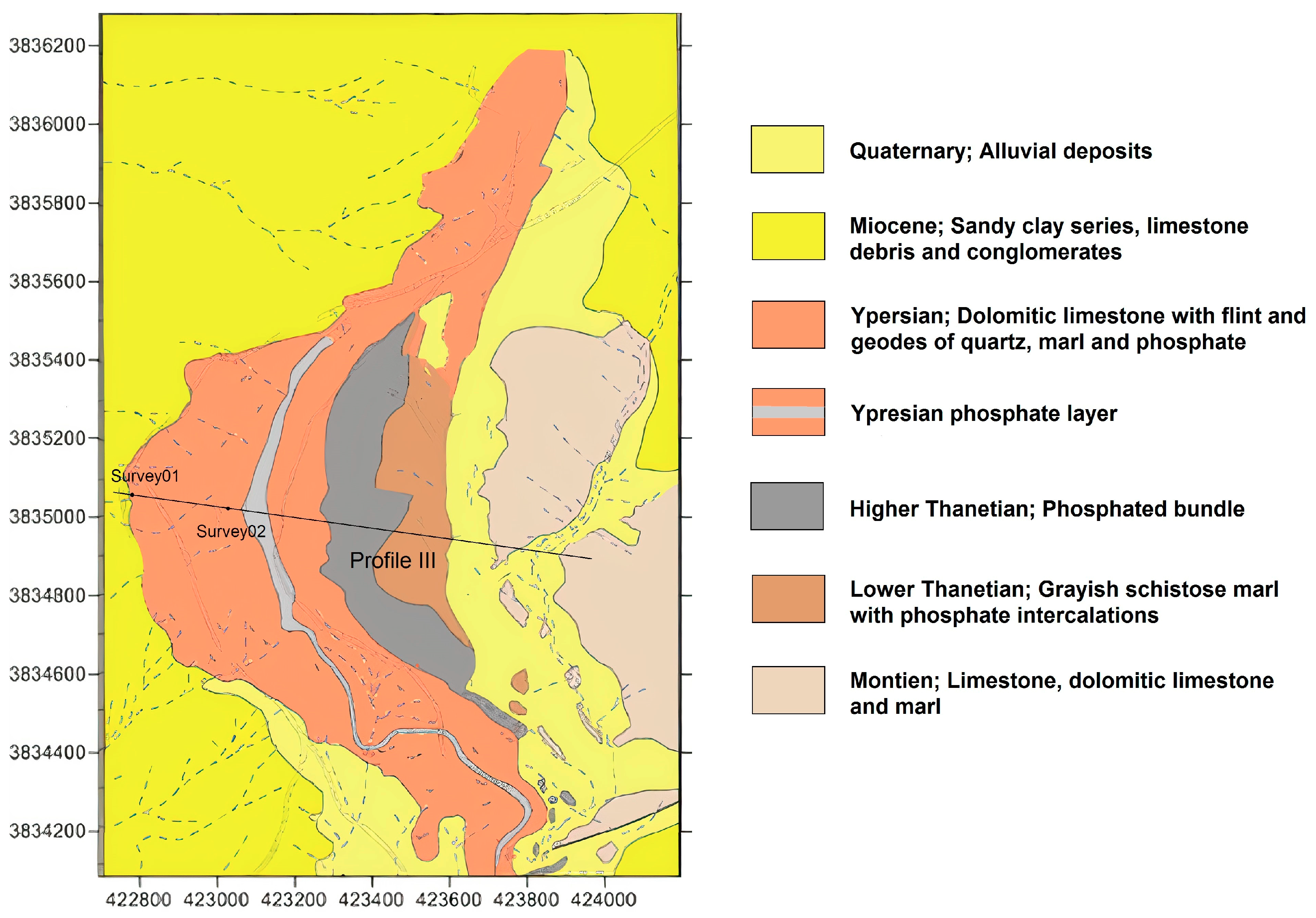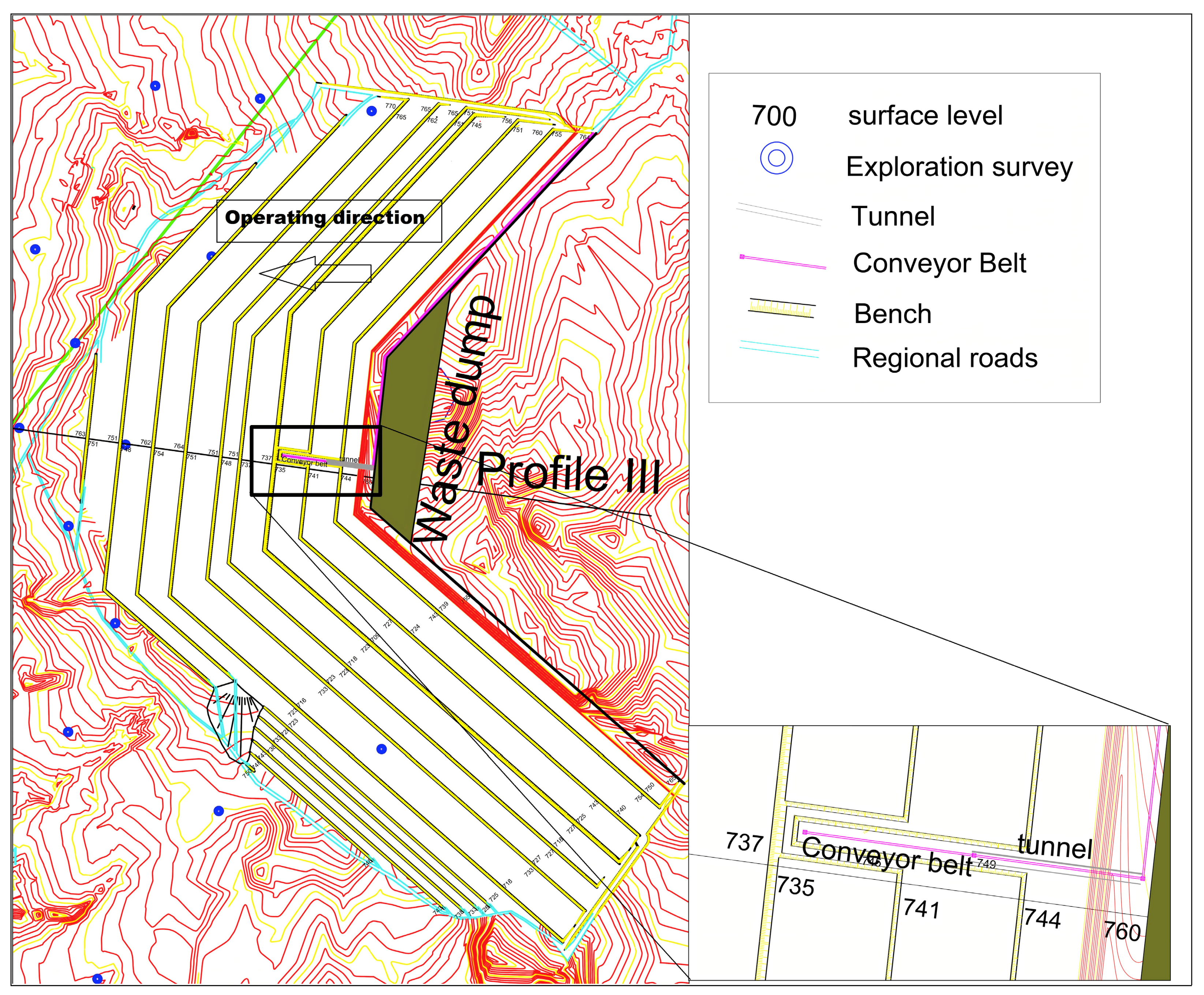A Tunnel under an In-Pit Mine Waste Dump to Improve Environmental and Landscape Recovery of the Site
Abstract
:1. Introduction
2. Materials and Methods
2.1. Site Characteristics
2.2. Site Exploration
2.3. Mine Design
3. Results of Open-Pit Recovery
4. Discussion
4.1. Advantages and Limitations of Tunnels
4.2. Environmental Recovery
5. Conclusions
5.1. General Conclusions
5.2. Future Work
Author Contributions
Funding
Data Availability Statement
Acknowledgments
Conflicts of Interest
References
- Commission of the European Communities. The Raw Materials Initiative—Meeting Our Critical Needs for Growth and Jobs in Europe. SEC 2008. Available online: https://eur-lex.europa.eu/legal-content/EN/TXT/?uri=CELEX:52008DC0699 (accessed on 27 April 2021).
- Conde, M. Resistance to mining. A review. Ecol. Econ. 2017, 132, 80–90. [Google Scholar] [CrossRef]
- Kivinen, S.; Kotilainen, J.; Kumpula, T. Mining conflicts in the European Union: Environmental and political perspectives. Fennia 2020, 198, 163–179. [Google Scholar] [CrossRef]
- Conde, M.; Le Billon, P. Why do some communities resist mining projects while others do not? Ext. Ind. Soc. 2017, 4, 681–697. [Google Scholar] [CrossRef]
- Manhart, A.; Vogt, R.; Priester, M.; Dehoust, G.; Auberger, A.; Blepp, M.; Dolega, P.; Kämper, C.; Giegrich, J.; Schmidt, G.; et al. environmental criticality of primary raw materials—A new methodology to assess global environmental hazard potentials of minerals and metals from mining. Miner. Econ. 2019, 32, 91–107. [Google Scholar] [CrossRef] [Green Version]
- U.S. Department of Energy. Critical Materials Rare Earths Supply Chain: A Situational White Paper. 2020. Available online: https://www.energy.gov/eere/amo/downloads/critical-materials-supply-chain-white-paper-april-2020 (accessed on 25 April 2021).
- Ghisellini, P.; Cialani, C.; Ulgiati, S. A review on circular economy: The expected transition to a balanced interplay of environmental and economic systems. J. Clean. Prod. 2016, 114, 11–32. [Google Scholar] [CrossRef]
- Su, B.; Heshmati, A.; Geng, Y.; Yu, X. A review of the circular economy in China: Moving from rhetoric to implementation. J. Clean. Prod. 2013, 42, 215–227. [Google Scholar] [CrossRef]
- Tukker, A. Product services for a resource-efficient and circular economy—A review. J. Clean. Prod. 2015, 97, 76–91. [Google Scholar] [CrossRef]
- Mission 2016. The Future of Strategic Mineral Resources. 2016. Available online: https://web.mit.edu/12.000/www/m2016/finalwebsite/solutions/greenmining.html (accessed on 23 March 2021).
- Bezzi, N.; Aïfa, T.; Merabet, D.; Pivan, J.-Y. Magnetic properties of the Bled El Hadba phosphate-bearing formation (Djebel Onk, Algeria): Consequences of the enrichment of the phosphate ore deposit. J. Afr. Earth Sci. 2008, 50, 255–267. [Google Scholar] [CrossRef]
- U.S. Geological Survey. Phosphate rock. Miner. Commod. Summ. 2017, 124–125. [Google Scholar] [CrossRef]
- Orgm. Rapport Final sur les Resultats des Travaux D’exploration des Phosphates du Gisement de Bled el Hadba 2012–2014; Orgm: Algeria Boumerdes, Algeria, 2015. [Google Scholar]
- Journal Officiel N°18. Algerian Mining Law. J. Off. Repub. Alger 2014, 18, 3–29. [Google Scholar]
- Minerai, P.; Hadba, B.E.; Ann, T.; Mat, S. Caracterisation physico-chimique du mineral de phosphate. In Annales de Chimie Science des Matériaux; Elsevier: Amsterdam, The Netherlands, 2001; Volume 26, pp. 5–23. [Google Scholar]
- Stage dans le Laboratoire de Somiphos; Tebessa, Algeria. Geologie, Hydrogeologie, Exploitation du Gisement de Bled el Hadba. Unpublished work. 2008. [Google Scholar]
- Osanloo, M.; Paricheh, M. In-pit crushing and conveying technology in open-pit mining operations: A literature review and research agenda. Int. J. Min. Reclam. Environ. 2020, 4, 430–457. [Google Scholar] [CrossRef]
- Freelance Technical Writer. Mining Engineering; Society for Mining, Metallurgy, and Exploration, Inc. (SME): Milwaukee, WI, USA, 2011; Volume 2. [Google Scholar]
- Menegaki, M.E.; Kaliampakos, D.C. Evaluating mining landscape: A step forward. Ecol. Eng. 2012, 43, 26–33. [Google Scholar] [CrossRef]
- Radolwoski, J.K. In-Pit Crushing and Vconveying as an Alternative to an All Truck System in Open Pit Mines. Ph.D. Thesis, The University of Mining and Metallurgy, Cracow, Poland, April 1965. [Google Scholar]
- Bajany, D.M.; Zhang, L.; Xia, X. An optimization approach for shovel allocation to minimise fuel consumption in open-pit mines: Case of heterogeneous fleet of shovels. IFAC-PapersOnLine 2019, 52, 207–212. [Google Scholar] [CrossRef]
- Nehring, M.; Knights, P.F.; Kizil, M.S.; Hay, E. A comparison of strategic mine planning approaches for in-pit crushing and conveying, and truck/shovel systems. Int. J. Min. Sci. Technol. 2018, 28, 205–214. [Google Scholar] [CrossRef]
- Fan, X.-M.; Ren, F.-Y.; Xiao, D.; Mao, Y.-C. Opencast to underground iron ore mining method. J. Cent. South Univ. 2018, 25, 1813–1824. [Google Scholar] [CrossRef]
- Khaboushan, A.S.; Osanloo, M. An uncertainty-based transition from open pit to underground mining. Int. J. Eng. 2019, 32, 1218–1224. [Google Scholar] [CrossRef] [Green Version]
- Nunes, R.A. A decision-making method to assess the benefits of a semi-mobile in-pit crushing and conveying alternative during the early stages of a mining project. Mining 2019, 72, 285–291. [Google Scholar] [CrossRef]
- Duarte, J.; Baptista, J.S.; Torres Marques, A. Occupational accidents in the mining industry: A short review. In Occupational and Environmental Safety and Health; Arezes, P.M., Baptista, J.S., Barroso, M.P., Carneiro, P., Cordeiro, P., Costa, N., Melo, R., Miguel, A.S., Perestrelo, G., Eds.; Springer International Publishing: Cham, Switzerland, 2019; pp. 61–69. [Google Scholar] [CrossRef]
- Norgate, T.; Haque, N. The greenhouse gas impact of IPCC and ore-sorting technologies. Miner. Eng. 2013, 42, 13–21. [Google Scholar] [CrossRef]
- Liu, F.; Cai, Q.; Chen, S.; Zhou, W. A comparison of the energy consumption and carbon emissions for different modes of transportation in open-cut coal mines. Int. J. Min. Sci. Technol. 2015, 25, 261–266. [Google Scholar] [CrossRef]






| Profile I | |||
|---|---|---|---|
| Layer | Total Bench Height of Each Layer (m) | Area (m2) | Volume (m3) |
| Sand and clay | 38 | 386,359 | 14,681,642 |
| Limestone and gypseous marl | 8 | 278,520 | 2,228,160 |
| Phosphate (top layer) | 8 | 331,612 | 2,652,896 |
| Limestone and gypseous marl | 21 | 498,611 | 10,470,831 |
| Phosphate (main layer) | 30 | 543,871 | 16,316,130 |
| Marl | 2 | 534,474 | 1,068,948 |
| Phosphate (lower layer) | 3 | 386,359 | 14,681,642 |
| Profile II | |||
| Sand and clay | 22 | 112,998 | 2,485,956 |
| Limestone and gypseous marl | 14 | 156,635 | 2,192,890 |
| Phosphate (top layer) | 29 | 187,723 | 5,443,967 |
| Limestone and gypseous marl | 15 | 327,645 | 4,914,675 |
| Phosphate (main layer) | 15 | 325,154 | 4,877,310 |
| Marl | 3 | 395,696 | 1,187,088 |
| Phosphate (lower layer) | 1 | 385,010 | 385,010 |
| Profile III | |||
| Sand and clay | 22 | 103,765 | 1,867,770 |
| Limestone and gypseous marl | 22 | 287,407 | 6,322,954 |
| Phosphate (top layer) | 6 | 305,378 | 1,832,268 |
| Limestone and gypseous marl | 17 | 436,796 | 7,425,532 |
| Phosphate (main layer) | 30 | 539,932 | 16,197,960 |
| Marl | 2 | 541,627 | 1,083,254 |
| Phosphate (lower layer) | 3 | 537,538 | 1,612,614 |
| Material | Total Volume Extracted from the Pit (m3) | Swell Factor | Total Volume after Fragmentation (m3) |
|---|---|---|---|
| Marl | 3,339,290 | 1.25 | 4,174,113 |
| Limestone and gypseous marl (m3) | 33,555,042 | 1.375 | 50,332,563 |
| Sand and clay (m3) | 19,035,368 | 1.2 | 22,842,442 |
| Phosphate (m3) | 50,892,774 | 1.5 | - |
| Total | 106,822,474 | - | 73,154,737 |
| Comparison with the Original Surface Level | |||
| The difference between total volumes (m3) | 33,667,737 | - | |
| Total exploited area (m2) | 1,743,166 | - | |
| The difference from the original surface level (m) | −19.3 | - | |
| Phosphate Processing Phases | Amount of Phosphate in Each Phase (%) | Performance of Each Phase (%) | Amount of Phosphate in Each Phase (m3) | Output of the Processing Plant (m3) | Rejects of Each Operation (m3) | Phosphate Swell Factor of Rejects (m3) |
|---|---|---|---|---|---|---|
| Screening after fragmentation | 100 | 95 | 50,892,774 | 48,348,135 | - | - |
| Rejects of the screening | - | - | 2,544,639 | 3,816,958 | ||
| Dry enrichment | 50 | 61 | 24,174,068 | 14,746,181 | 9,427,886 | 14,141,830 |
| Wet enrichment | 50 | 70 | 24,174,068 | 16,921,847 | 7,252,220 | 10,878,330 |
| Total (m3) | - | - | - | 31,668,029 | 19,224,745 | 28,837,118 |
| Comparison with the Original Surface Level Considering the Tailings | ||||||
| The total volume removed from the pit (m3) | 106,822,474 | - | ||||
| The volume of waste including the tailings (m3) | 101,991,855 | - | ||||
| The difference between volumes (m3) | 4,830,619 | - | ||||
| Total exploited area (m2) | 1,743,166 | - | ||||
| The mean difference from the original surface level (m) | −2.77 | - | ||||
Publisher’s Note: MDPI stays neutral with regard to jurisdictional claims in published maps and institutional affiliations. |
© 2021 by the authors. Licensee MDPI, Basel, Switzerland. This article is an open access article distributed under the terms and conditions of the Creative Commons Attribution (CC BY) license (https://creativecommons.org/licenses/by/4.0/).
Share and Cite
Rebbah, R.; Duarte, J.; Djezairi, O.; Fredj, M.; Baptista, J.S. A Tunnel under an In-Pit Mine Waste Dump to Improve Environmental and Landscape Recovery of the Site. Minerals 2021, 11, 566. https://doi.org/10.3390/min11060566
Rebbah R, Duarte J, Djezairi O, Fredj M, Baptista JS. A Tunnel under an In-Pit Mine Waste Dump to Improve Environmental and Landscape Recovery of the Site. Minerals. 2021; 11(6):566. https://doi.org/10.3390/min11060566
Chicago/Turabian StyleRebbah, Rania, Joana Duarte, Omar Djezairi, Mohamed Fredj, and João Santos Baptista. 2021. "A Tunnel under an In-Pit Mine Waste Dump to Improve Environmental and Landscape Recovery of the Site" Minerals 11, no. 6: 566. https://doi.org/10.3390/min11060566







